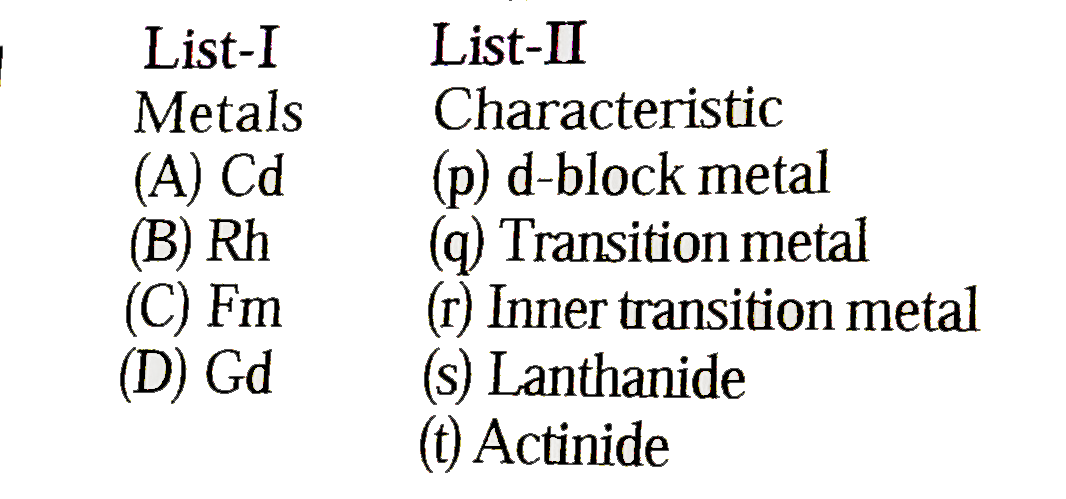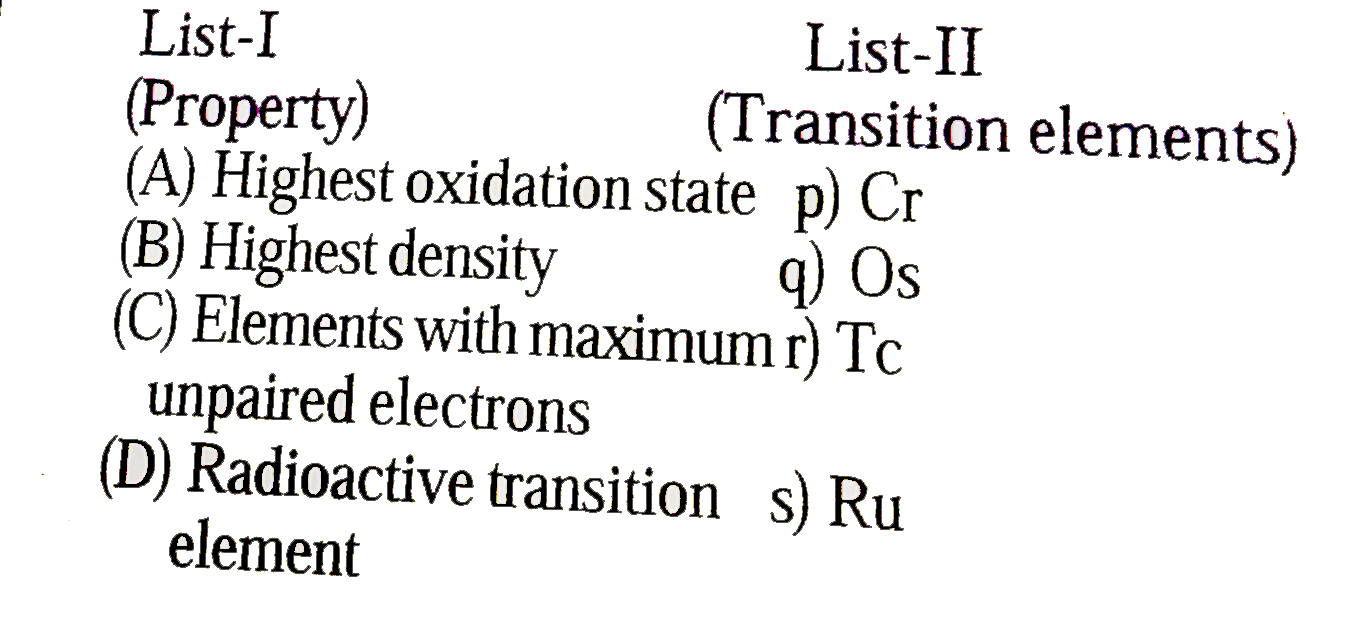Complete Solutions to Level-V (H.W) of chapter D BLOCK & TRANSITION ELEMENTS of Class 12 book with complete answers and questions
| Class 12 | CHEMISTRY |
| Chapter | D BLOCK & TRANSITION ELEMENTS |
| NARAYANA | Level-V (H.W) |
| Number Of Questions | 47 |
| Academic Year | 2023-24 |
There are 3 unpaired electrons in `[Co(H_(2)O)_(6)]^(2+)` and calculated value of magnetic moment on the basis of `sqrt(n(n+2))` is `3.87 BM`, which is much lower than the experimental value of `4.4 BM`. The reason for this difference is due to :
View SolutionMetallic radii of some transitions element are given below. Which of these elements will have highest density ?
`{:("Element",Fe,Co,Ni,Cu),("Metallic",126,125,125,128),("radii/pm",,,,):}`
View SolutionWhich of the following is amphoteric oxide?
`Mn_(2)O_(7),CrO_(3),Cr_(2)O_(3),CrO,V_(2)O_(5),V_(2)O_(4)`
View SolutionThe magnetic moment is associated with its spin angular momentum and orbital angular momentum. Spin only magnetic moment value of `Cr^(3+)` ion is
View SolutionIonisation energies of `Ni` and `Pt` in `KJmol^(-1)` are given below
`{:(,ubrace((IE)_(1)+(IE)_(2)),ubrace((IE)_(3)+(IE)_(4))),(Ni,2.49,8.80),(Pt,2.60,6.70):}`
So, (select the correct statement)
View SolutionAtoms of the transition element are smaller than those of the s-block elements, because :
View SolutionStandard reduction electrode potential of `Zn^(2+)//Zn` is -0.76V`. This means:
View Solution`E^(Theta)` value for the couple `Cr^(3+)//Cr^(2+)` and `Mn^(3+)//Mn^(2+)` are `-0.41 and +1.51` volts respectively. Considering these value select the correct option from the following statements.
View SolutionOf the ions `Zn^(2+),Ni^(2+) and Cr^(3+)` (atomic number Zn=30,Ni=28,Cr=24):
View SolutionIron is rendered passive by treatment with concentrated
View SolutionWhich of the following dissolves in hot concentrated NaOH solution?
View SolutionAmong the following, identify the species with an atom in `+6` oxidation state.
View SolutionThe pair of compounds having metals in their highest oxidation state is:
View SolutionWhich of the following pair of compounds is expected to exhibit same colour in aqueous solution?
View SolutionAmong the following the coloured compound is .
View SolutionThe colour of `KMnO_(4)` is due to
View SolutionWhich of the following statement are correct about `Cr^(2+)` (Z = 24) and `Mn^(3+)` (Z = 25) ?
(i) `Cr^(2+)` is a reducing agent
(ii) `Mn^(3+)` is an oxidizing agent
(iii) Both `Cr^(2+)` and `Mn^(3+)` exhibit `d^(4)` configuration
(iv) When `Cr^(2+)` is used as a reducing agent, the chromium ion attains `d^(5)` electronic configuration
View SolutionAqurated copper (I) catin undergoes disproportionation as
`2Cu^(+)(aq) rarr Cu^(2+) (aq) + Cu`, because
View SolutionIn solution, the stability of the d-block compounds depends upon electrode potential. The electrode potential depends upon which of the following parameters.
(i) Entlhalpy of sublimation
(ii) Ionisation enthalpy
(iii) Hydration enthalpy
View SolutionWhich of the following is the best oxidant?
View SolutionWhich of the following is the best reductant?
View SolutionMn shows its highest oxidation state in its
View SolutionTransition elements form binary compounds with halogens. Which of the following elements will form `MF_(3)` type compounds?
View SolutionOrder of paramagnetic character among following element is/are"
View SolutionWhich of the following statement(s) is/are correct
View SolutionCorrect statements among the following is/are:
View SolutionThe correct statement among the following is:
View SolutionWhich of the following statement is/are correct?
View SolutionWhich of the following is/are correct statement(s)
View SolutionIdentify the correct statement(s)?
View SolutionWhich are the true statements regarding ionization energy of d-series elements?
View SolutionTransition metals usually from coloured complexes and d-d transitions `(t_(2g)hArre_(g))` are responsible for colour as the energy difference between `t_(2g)` and `e_(g)` lies in visible region. But all the coloured ions are not dut to d-d transition but charge transfer bands also play important roles. Charge transfer bands may be of two types.
(i) ligand to metal (CTLM)`" "(ii)` metal to ligand (CTML).
Charge transfer transition always produces intense colour as compared to d-d transition.
Select the incorrect statement `:`
View SolutionTransition metals usually from coloured complexes and d-d transitions `(t_(2g)hArre_(g))` are responsible for colour as the energy difference between `t_(2g)` and `e_(g)` lies in visible region. But all the coloured ions are not dut to d-d transition but charge transfer bands also play important roles. Charge transfer bands may be of two types.
(i) ligand to metal (CTLM)`" "(ii)` metal to ligand (CTML).
Charge transfer transition always produces intense colour as compared to d-d transition.
`MnO_(4)^(-)` is dark purple coloured though Mn is in `(+VII)` oxidation state with `3d^(@)` configuration
View SolutionTransition metal and their compounds are used as catalyst in industry and in biological system. For example, in the Contact Process, vanadium compounds in the +5 state `(V_(2)O_(5) or VO_(3)^(-))` are used to oxidise `SO_(2)` to `SO_(3)`:
`SO_(2)+(1)/(2)O_(2) overset(V_(2)O_(5))(to) SO_(3)`
It is thought theta the actual oxidation process takes place in two stages. In the first step, `V^(5+)` in the presence of oxide ions converts `SO_(2)` to `SO_(3)`. At the same time, `V^(5+)` is reduced to `V^(4+)`.
`2V^(5+)+O^(2-)+SO_(2) to 2V^(4+)+SO_(3)`
In the second step, `V^(5+)` is regenerated from `V^(4+)` by oxygen:
`2V^(4+)+(1)/(2)O_(2) to 2V^(5+)+O^(2-)`
The overall process is, of curse, the sum of these two steps:
`SO_(2) +(1)/(2)O_(2) to SO_(3)`
Q. Transition metals and their compounds catalyse reactions because:
View SolutionTransition metal and their compounds are used as catalyst in industry and in biological system. For example, in the Contact Process, vanadium compounds in the +5 state `(V_(2)O_(5) or VO_(3)^(-))` are used to oxidise `SO_(2)` to `SO_(3)`:
`SO_(2)+(1)/(2)O_(2) overset(V_(2)O_(5))(to) SO_(3)`
It is thought thta the actual oxidation process takes place in two stages. In the first step, `V^(5+)` in the presence of oxide ions converts `SO_(2)` to `SO_(3)`. At the same time, `V^(5+)` is reduced to `V^(4+)`.
`2V^(5+)+O^(2-)+SO_(2) to 2V^(4+)+SO_(3)`
In the second step, `V^(5+)` is regenerated from `V^(4+)` by oxygen:
`2V^(4+)+(1)/(2)O_(2) to 2V^(5+)+O^(2-)`
The overall process is, of curse, the sum of these two steps:
`SO_(2) +(1)/(2)O_(2) to SO_(3)`
Q. Catalytic activity in transition metals depends on:
View SolutionTransition metal and their compounds are used as catalyst in industry and in biological system. For example, in the Contact Process, vanadium compounds in the +5 state `(V_(2)O_(5) or VO_(3)^(-))` are used to oxidise `SO_(2)` to `SO_(3)`:
`SO_(2)+(1)/(2)O_(2) overset(V_(2)O_(5))(to) SO_(3)`
It is thought thta the actual oxidation process takes place in two stages. In the first step, `V^(5+)` in the presence of oxide ions converts `SO_(2)` to `SO_(3)`. At the same time, `V^(5+)` is reduced to `V^(4+)`.
`2V^(5+)+O^(2-)+SO_(2) to 2V^(4+)+SO_(3)`
In the second step, `V^(5+)` is regenerated from `V^(4+)` by oxygen:
`2V^(4+)+(1)/(2)O_(2) to 2V^(5+)+O^(2-)`
The overall process is, of curse, the sum of these two steps:
`SO_(2) +(1)/(2)O_(2) to SO_(3)`
Q. Which of the following ion involved in the above process will show paramagnetism?
View SolutionThe oxide formed in the maximum oxidation state is `ZrO_(x).x` is
View SolutionHow many of the following reactions cannot occur?
`(1) Fe+2HClrarrFeCl_(2)+H_(2) uarr`
`(2) Cu+2HClrarr CuCl_(2)+H_(2)uarr`
`(3) Cu+ZnSO_(4)rarrCuSO_(4)rarrCuSO_(4)+Zndarr`
`(4) Zn+2AgNO_(3)rarrZn(NO_(3))_(2)+2Agdarr`
`(5) Cu+2AgNO_(3)rarrCu(NO_(3))_(2)+2Agdarr`
`(6) Fe+CuSO_(4)rarrFeSO_(4)+Cudarr`
View SolutionThe number of transition metals in the alloy Alnico is
View SolutionWhat is the composition of the alloy Alnico?
View SolutionA compound of vanadium has a magnetic moment `(mu)` of `1.73 BM`. If the vanadium ion in the compound is present as `V^(x+)`, then, the value of `x` is ?
View SolutionNumber of outer most `'d'` electrons in Rhodium are
View SolutionThe sum of ns and `(n-1)d` electrons in Tc are
View SolutionHow many 3d series elements (Sc to Zn) have positive standard potential for `M^(2+)//M`?
View SolutionMatch the pair of substance having similar properties

View SolutionMatch the following

View SolutionMatch the following

View Solution
Level-V (H.W) questions and complete solutions for chapter D BLOCK & TRANSITION ELEMENTS of NARAYANA CHEMISTRY (HINGLISH) of Class 12